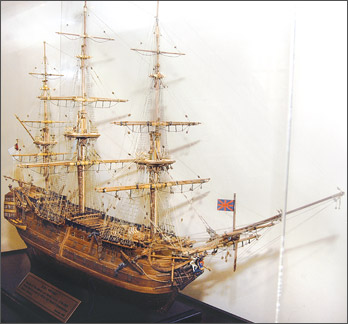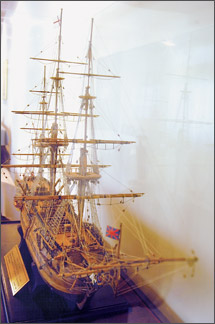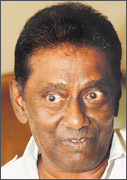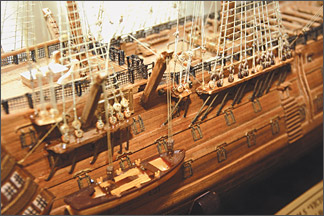‘Victory’ in shipshape
Thanks to Lankan seafarer:
Jayanthi Liyanage
Lord Nelson commissioned his flagship H.M.S. Victory in 1778. Two
hundred years later, Captain Shanti Goonewardene, serving as Master of
the merchant vessel Lanka Rani purchased the model kit of “Victory” from
a model Shop when the ship docked at Liverpool in the U.K.
|
 
The miniature replica of H. M. S. Victory |
Now completing 49 years as a seafarer with the merchant navy, he has
assembled the miniature replica of H.M.S. Victory. “I bought the kit
with 13 plans of the ship in Liverpool in 1978”, Capt. Goonewardene
said. “For 22 years, the kit lay in a cupboard and I decided to build
it. This is an actual scale model done in wood to the scale of 1:98.”
The kit produced by Mantua Models of Italy cost him Sterling Pounds
seventy five. It was recommended for the more advanced builder, being a
rather advanced and intricate model. Today, this kit is available at
U.S. $ 400.
“After taking the plans out of the box, building the ship took eight
years because I had been sailing in and out of ships. I finished the
last part of the ship, staying at home for ten months. I worked about
eight hours a day, four in the morning and four in the afternoon doing
the masts and the rigging. It takes about three years to build a model
like this, working continuously. It is very intricate work with the
inside of the ship too built to scale,” Capt. Goonewardene said.
When Lanka Rani sailed from Liverpool and called at Hamburg in
Germany, he showed the vessel’s local agents M/S. Unimar Seetransport
GmbH the kit containing the model. “The next day the Management of
Unimar presented me with a book titled ‘Fighting Sail’ which was all
about the Battle of Trafalgar, the life of Lord Nelson and H.M.S.
Victory.” Later, he downloaded photographs of “Victory” from the
internet which helped him in his work of building the model. Capt.
Goonewardene said that 18 frames, according to the plans, had to be cut
out and slotted onto the Walnut keel to show the decks. “They came in
boxwood. Its Norwegian Danish wood, coming with the kit and does not
decay.”
|

Captain Shanti Goonewardene
Pictures by Ruwan de Silva |
The first step of assembling the model was to cut out all the frames
for which purpose, he had to purchase an electric table model scroll
saw. The 13 plans displayed how to build the ship at each step. The
final plan showed the rope work and the rigging. “The rope work is
exactly how it is in the original vessel, now preserved at Portsmouth in
the U.K.,” he said.
Capt. Goonewardene served in the Lanka Rani for a spell of six and a
half years with no break. His wife Santi too was on the ship for four
and a half years. “It was like our home,” she said. “Ships in that era
were like old bungalows.” When a ship was at a port, it usually would be
anchored for about three weeks, giving the occupants time to look
around. But the modern container vessels arrive at a port in the morning
and leave in the evening.
Capt. Goonewardene said that being locked up in a cupboard for 22
years, the wooden parts that had come apart, had to be re-glued.
|

The intricate interior of H. M. S. Victory |
In the years of 2001 and 2002, he was sailing and visited the
Australian ports of Adelaid and Fremantle wherein he obtained the
necessary tools and high quality glues. “The copper sheet that covered
the hull of “Victory” below the water level to protect it from insects
was not supplied with the kit. I got the copper sheeting from a ‘bothal
kade’ in Maradana. To obtain the riveting effect, I used my wife’s dress
making tracing wheel.” Work started on the model in 2000 was completed
in September 2008.
“I will never sell ‘Victory’,” says Capt. Goonewardene. “We have no
children so it might go to a nephew or to the maritime Museum in Galle.
“If anyone wants to build a model like this, my advice is that you
must have all tools. I have a comprehensive collection of model making
tools. You can’t borrow them,” he points out.
“The second requirement is you must have a very patient wife. Having
lunch at 1500 hrs and dinner at 2300 hrs is not healthy for a person of
my age but that was the case.”
What would be his next project? “I have the hull of a ship which I
picked up on a ship I was sailing on. It is a modern container vessel. I
have no plans on that and will have to improvise and build it in the way
I think it should be done”. He used to build model aircraft but due to
the present day security situation, he has called it a halt.
------------------********
The battleship H.M.S. “Victory”, a first rate 104 Gun Ship designed
by Sir Thames Slades, a Surveyor of the Navy, became famous during the
Battle of Trafalgar when she was commanded by Lord Nelson. The only ship
of its class built in 1759-1765 at the Chatham Dockyard for the Royal
Navy, she was commissioned in 1778 and was a fearsome fighting machine
with almost thirty years of hard service.
As a “first rater”, she commanded the power of 102 cast-iron Cannons
ranging from 12 to 32 pounders lining three gun decks, plus two short
range Carronades that could fire an immense 68 pound ball. In a single
devastating broadside, she could let loose half a ton of Iron shot
propelled for more than a mile by 400 pounds of gunpowder.
Even at that extreme range the round shot from a 32 pounder could
smash through two feet of solid Oak. Aside from her keel, which was
constructed of Elm because it could be obtained in the large size
required, the Victory’s Hull was built entirely of Oak.
It took 2,500 prime trees - equivalent to 60 acres of century old
forest - to fashion her massive ribs, some two feet thick and her heavy
double planking. Her rudder an Oak Blade six feet wide at the base and
38 feet tall was controlled from the double wheel on the quarter-deck by
ropes and pulleys connected to a 29 foot tiller on the lower gun deck.
Both the rudder and the Hull below the water line were sheathed in
Copper as a guard against borers and speed-retarding barnacles.
The tallest of the Victory’s three masts towered 205 feet above the
water line. The masts were made of Fir for its flexibility, and were
constructed in three sections for ease in maintaining and because no
trees were tall enough by themselves. These spires up to three feet
thick at the base were secured to the Victory’s Hull by five miles of
standard rigging. From their yards could be hung 32 sails - four acres
of canvas when she was under full sail. The Victory could plough along
at 10 knots in a stiff breeze.
Fair weather or foul, the Victory was a mobile fortress-city stocked
with 35 tons of powder and 120 tons of shot, and capable of staying at
sea for several months at a time.
-------------------********* |



